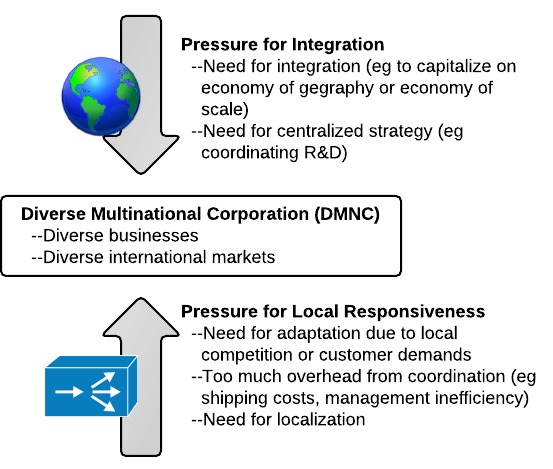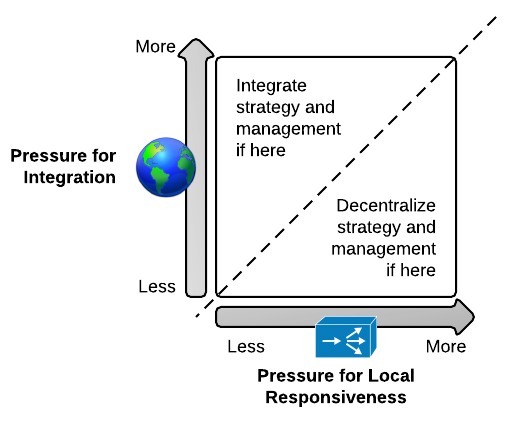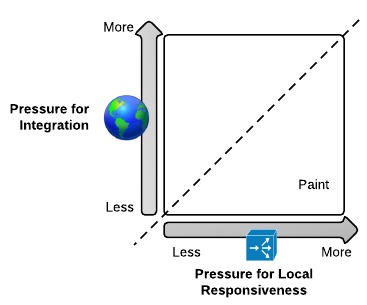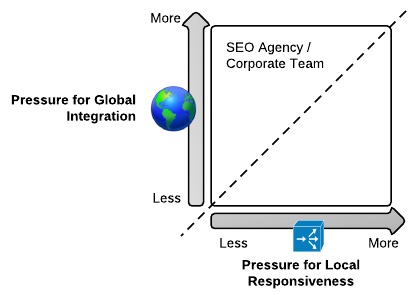This blog post is about a management study already 29 years old. The post culminates in an explanation of a type of chart that was used by the authors of the study to discuss the business strategies of “Diverse Multinational Corporations” (a phrase that even Google can barely remember).
So why this esoteric blast from the past? How can an archaic whiteboard maneuver (I guess it was called a blackboard back then) developed to discuss the global strategies of a company like Phillips circa 1980 be leveraged to help shape your next SEO or Social Media campaign, circa 2011? Simply put: Any modern company with a business model dependent on organic search or impressions from social media is now “globally integrated”, in terms of distribution, market dynamics, and technological infrastructure, at a level that far surpasses even the largest multinational corporation of 1974. And given the requirement for acute tactical agility needed to perform regional search optimization, social media optimization, and adjust for local or niche market dynamics, the opposing pressure for distributed management and local responsiveness, away from centralized integration, is just as real now as it was then.
At Ginzametrics we believe that properly applied first principles, in this case regarding centralized vs decentralized management, can help us and our partners develop effective and coherent digital strategies for the ubiquitously online 21st century, just like they helped the dominant DMNCs of the 1980s develop the competitive market strategies that enabled them to transform global business, back when video killed the radio star .
Background
In 1974, two doctoral students at Harvard, C.K. Prahalad and Yves L. Doz, began studying Diverse Multinational Corporations (DMNCs), a new breed of large global corporations competing in multiple diverse business areas while operating distribution channels spanning multiple national markets.
Armed with the rigor of academic methodology and an understanding of the substantive issues management imparted on them by their mentor Professor Joseph L. Bower , Prahalad and Yves set out to discover what separated dominant DMNCs from the competition they were outperforming. Over the course of the next six years, they read countless corporate documents and interviewed more than 500 top executives from over 20 global firms, including General Motors, GTE, IBM, Philips, Brow Boveri, Nippon, Corning Glass Works, Massey Ferguson, and Ciba-Geigy.
Global Integration vs Local Management
What Prahalad and Doz discovered was that the most dominant DMNCs formulated explicit strategies leveraging the issue of “global integration” vs “local management”.
Prahalad and Doz isolated two major forces acting DMNCs:

- Pressures for Global Integration
- Pressures for Integration of Activities — It is often necessary to centralize the management of geographically dispersed activity in order to reduce cost and optimize investment. A good example is moving an entire corporation’s manufacturing operations to a single factory site in New Jersey in order to capitalize on the resultant economy of scale. A further example along this line would be relocating that factory to Taiwan in order to capitalize on economy of location.
- Pressures for Integration of Strategy — This is pressure to capitalize on the competitive advantages associated with the centralized resource allocation for strategic purposes. An example is the free drink given to you by the cocktail waitress hovering around the slot machines at a casino in Las Vegas. The bar can give away drinks, so long as patrons are losing more money gambling than they would normally spend on alcohol. (And of course getting people drunk before gambling also helps in it’s own strategic way.) It is part of the casino’s strategy to lose money on drinks and make it up in other departments.
- Pressures for Local Management — In many situations there is no competitive advantage to global integration/coordination, or global integration is actually detrimental, eg there is too much logistical or management overhead associated with global coordination, or local market and customer demands turn out to be more important. The last time I was at a McDonald’s in India I was introduced to the Chicken Maharaja Mac. Before that I met the McVeggie. Apparently cheeseburgers aren’t selling there.

In their book that captured the results of the study, The Multinational Mission, Prahalad and Doz argue that the most effective DMNCs explicitly formulated their corporate strategies in reaction to these forces:
Otis elevator saw an opportunity in the late 1960s to integrate its operations in the elevator market in Europe. At that time the market was dominated by local firms; most MNCs also operated on a locally responsive mode. Through a process of acquisitions and consolidations, by standardizing elevator design, and by cutting costs, Otis changed the rules of the game. It changed the economics of the industry to a point where regional integration, if not global integration became the dominant mode. The first company to innovate and exploit that change can gain a considerable advantage over its competitors, who are slower to move toward international integration.
The success of Japanese competitors in a variety of industries can be attributed to their ability to pick primarily locally responsive industries, even those populated by MNCs, and change them to globally integrated businesses. Examples abound. Traditional competitors who were multinational prior to the Japanese competitive thrust in the auto industry (e.g. General Motors), ball bearings (e.g. SKF), and television sets (e.g. Phillips) operated on a locally responsive basis. They were caught off guard. Once a determined competitor changes the rules of the game, the degrees of freedom available to others may be limited…
Of course they point out that global integration, is not always the correct strategy:
For example, when a processed food firm, Nabisco, went overseas, its management assumed the business could be managed centrally and that the benefits of coordinating in advertising and product development outweighed the benefits of local responsiveness. It soon became apparent that the habits of the consumers were harder to change in some of the businesses than originally thought; a locally responsive strategy made more sense.
Bottom line: the most successful DMNCs cleanly partitioned their organization and strategies to fall into either the “globally integrated” or “locally managed” bucket.
Global Integration vs Local Management is Part of Your SEO Reality
Even for a 3-man software startup there are pressures towards centralization (such as version control and code reviews) and also pressures towards decentralization/responsiveness (such as critical hotfixes when the server goes down).
Craig Macdonald, writing at SearchEngineWatch.com, speculated that Global SEO Programs will Decentralize to a Regional Governance Model . This article elaborates on “centralization vs decentralization” forces acting on large SEO campaigns:

- Pressures for Global Integration of SEO Campaigns
- Pressures for Integration of Activities — Standardization, budget control, efficiency, and QA.
- Pressures for Integration of Strategy — Unified brand strategy, the need to consolidate reporting from multiple programs to analysts and corporate decision makers
- Pressures for Local Management of SEO / Social Media Campaigns — Viral social media programs require “identification and marketing to influencers”, which requires knowledge of the localized market dynamics. Global reach sometimes requires optimization of content and strategy towards disparate regional markets. Content and web development is often run by distinct agencies.
As pointed out by Mr Macdonald: the most effective way to respond to these pressures is to decentralize the management of appropriate activities, and to augment tools and processes to ensure global oversight, efficiency, and coordination when necessary.
How This Helps Us Think About Ginzametrics
Ginzametrics is an industrial strength reporting and analytics dashboard specifically architected to implement the global integration of large-scale SEO campaigns. Learning from the lessons of the DMNCs, we make sure Ginzametrics solves issues of “global integration” vs “local management” for our customers:
- We ensure that we can track keywords in any language, and support 20 different localized search engines, with even more search engines available in early access.
- We are constantly working to push our scalability to global levels
- We integrate our SEO metrics and reporting capability with other popular digital marketing infrastructure, such as Google Analytics and Omniture, to help tie these disconnected systems together
- We engineered our “account” and “site” centric workflow to make it possible and even easy to mange and oversee a huge number of sites, with each site composed of thousands or hundreds of thousands of pages.
- Our SEO Page Rules and other automated features, including automatic keyword discovery, ensure highly scalable global oversight and reporting over many locally managed campaigns.
- We strive to keep our UX simple, so that use of Ginzametrics doesn’t add any more overhead to the challenge of global integration
A Simple Chart
In The Multinational Mission, Prahalad and Doz introduce a simple tool for performing “global integration” vs “local management” themed analysis on your organization or business plan.
They named this chart the Integration Responsiveness Grid, or “IR Grid”.

The IR Grid is a two dimensional graph, where one dimension is “Pressure for Global Integration” and “Pressure for Local Responsiveness”. Analysis is performed by placing dots representing characteristics of your organization/plan on the grid. The X/Y placement of the dot is based on the amount of pressure from the two axis.
The trick performed by dominant DMNCs, according to Prahalad and Doz, was cleanly partitioning different characterizations of their strategies towards “globally integration” or “locally management”. This effective partitioning enabled them to highly optimize execution in alignment with these forces. Leveraging this optimization enabled them to overpower their competition in tactical scenarios.
Where the IR Grid comes into play is that it puts this perspective into the form of a very simple chart, helping you quickly perform this complex analysis in an intuitive way. Thus, the trick to utilizing the IR grid is to try to break down the elements of your strategy and reorganize them so that the most important dots land near one of two regions:
- The corner where Pressure for Integration is high and Pressure for Local Responsiveness is low. If a dot is here, make sure you manage it centrally.
- The corner where Pressure for Local Responsiveness is high and Pressure for Global Integration is low. If a dot is here, make sure you manage it locally.
Let us consider a historical example from the book: a DMNC circa 1985 that happens to produces paint in addition to other products.

If the management team of this DMNC had placed all the different product lines on the IR grid in the early 80s, they would seen a trend emerging: house paint would still be predictably hanging out talking amongst themselves in the “locally manage” corner (taste and regulation for house paint is regional), but the car paint products would have made a surprising migration up into the “global integration” corner, actively socializing with other global product lines buying rounds of tequila for everyone. Why? The automobile industry had recently become global in terms of sourcing, design, and manufacturing. Since paints had historically been manufactured with the locally managed House Paint market in mind, this management team would have seen an opportunity to capitalize on central integration and leverage the other paint suppliers out the car market:

If we applied this chart to an SEO campaign, we would have seen SEO-related our dots cluster in the “central integration” corner in response to the pressures of budget control and efficiency.

Applying the same decomposition and analysis to a large SEO campaign in 2011, however, we would quickly see that certain aspects of our campaign (such as identifying and marketing to influencers as part of viral social media programs) are under serious pressure towards local responsiveness.

Clearly identifying which aspects of your campaign would be most effective locally managed, and which must stay highly centrally integrated, will help you formulate a strategy for success. In addition to helping you perform this analysis, the IR Grid can also help you visually communicate this strategy in a simply and intuitive way.
The Bottom Line
Don’t overlook the issue of “integration vs decentralized management” as an opportunity to focus your resources to leverage against your competitors. The IR Grid can help you do quick “integration vs decentralized management” themed analysis on your strategy. Ginzametrics can help you globally integrate locally or regionally managed SEO campaigns on an industrial scale.

